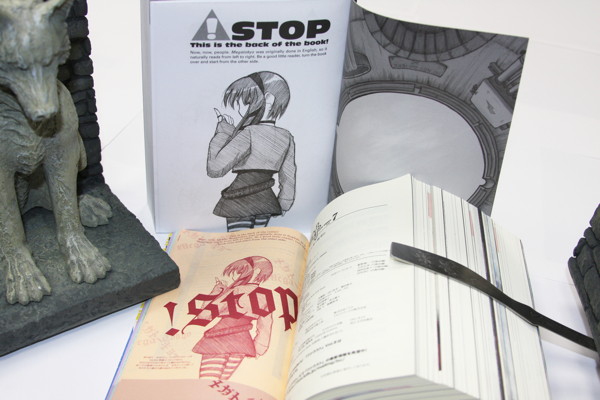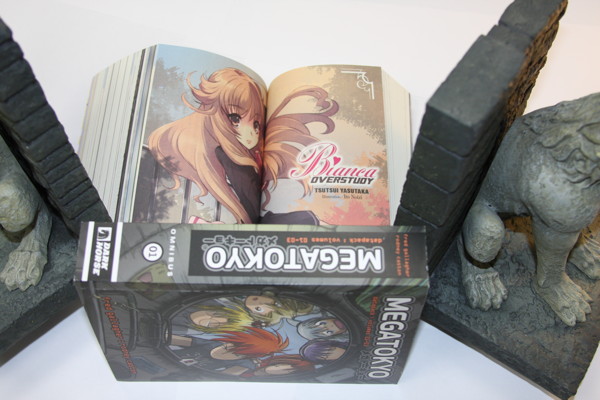Many comics creators around the world have taken inspiration from manga—I was about to type "English-language comics creators," but that hardly pays justice to the influence Japan has on all continents; I bet even the scientists in Antarctica draw doujinshi throughout that six-month night. But only a few have ever taken that inspiration all the way back to Japan, and seen their work published there, appearing translated alongside the manga within a Japanese magazine. Fred Gallagher and Rodney Caston's Megatokyo—whose collected omnibus edition subtitled datapack: volumes 01-03 hits stores this week—is one of those few.

Now, as you might guess, Dark Horse's new edition of Megatokyo is the book on the left. But next to it on the right is the magazine in which the Japanese edition of Megatokyo appeared, inside the giant-sized (over 1200 pages!) Summer 2008 issue of Kodansha's Faust. Fred Gallagher wrote the afterword to Oh My Goddess! COLORS, in which he recalled his first encounter with the manga, and how Kosuke Fujishima became one of his greatest influences. It was fitting that it was Kodansha, who publishes the original Oh My Goddess!, should also publish Megatokyo in Japan; some of you may have also encountered the two English editions of Faust that were released by Del Rey in 2008-09.
As you can see, the Megatokyo omnibus, in the tradition of Japanese manga magazines, is thick, and ideally to hold these books open we should have used something both cute and dense, like Ayumu Kasuga. However, in the spirit of Dark Horse's eclectic publishing program, we instead used these Game of Thrones Direwolf Bookends. I suppose it could be Mr. Tadakichi if you squint.

For years, most manga published in English have been printed in the typical Japanese reading order, right-to-left (I say "typical" because the Japanese do sometimes use left-to-right; there are even manga done that way—Kenichi Sonoda did it with his Riding Bean story in the back of the Gunsmith Cats Revised Edition Vol. 4). The result is that the unsuspecting foreign newcomer, thinking they're at the start of a manga, instead gets greeted by a sternly-worded command to make like The Byrds and turn, turn, turn. The new Megatokyo omnibus (at the top) contains a number of facetious warnings of this type, as of course, being an American comic, it's read left-to-right. But in Faust (at the bottom) it actually did need a warning about direction, for the benefit of the Japanese readers.

Here's a page from the English Megatokyo, and the same page in Japanese as it appeared in Faust. You'll have noticed that the Japanese version was on cream-colored paper; printing different sections of a manga magazine on different-colored paper is a long tradition in Japan, although not every magazine does so.

On purple paper: a manga just down the block from Megatokyo in the pages of Faust was Nonboruto. Does the style look familiar? That's because it's by Hajime Ueda of FLCL!

In Japan, Megatokyo lived in an attractive neighborhood. Also in that issue of Faust was the story Bianca Overstudy by Yasutaka Tsutsui, who wrote the novels that both Mamoru Hosoda's The Girl Who Leapt Through Time and Satoshi Kon's Paprika were based upon. The illustrations for Bianca Overstudy were done by visual novel character designer Noizi Ito, perhaps best known in English for her work on Shakugan no Shana.
That was Megatokyo in Japan...but it's back here at home at last this week in North America! The Megatokyo Omnibus is on sale April 9.
—Carl Horn
Manga Editor